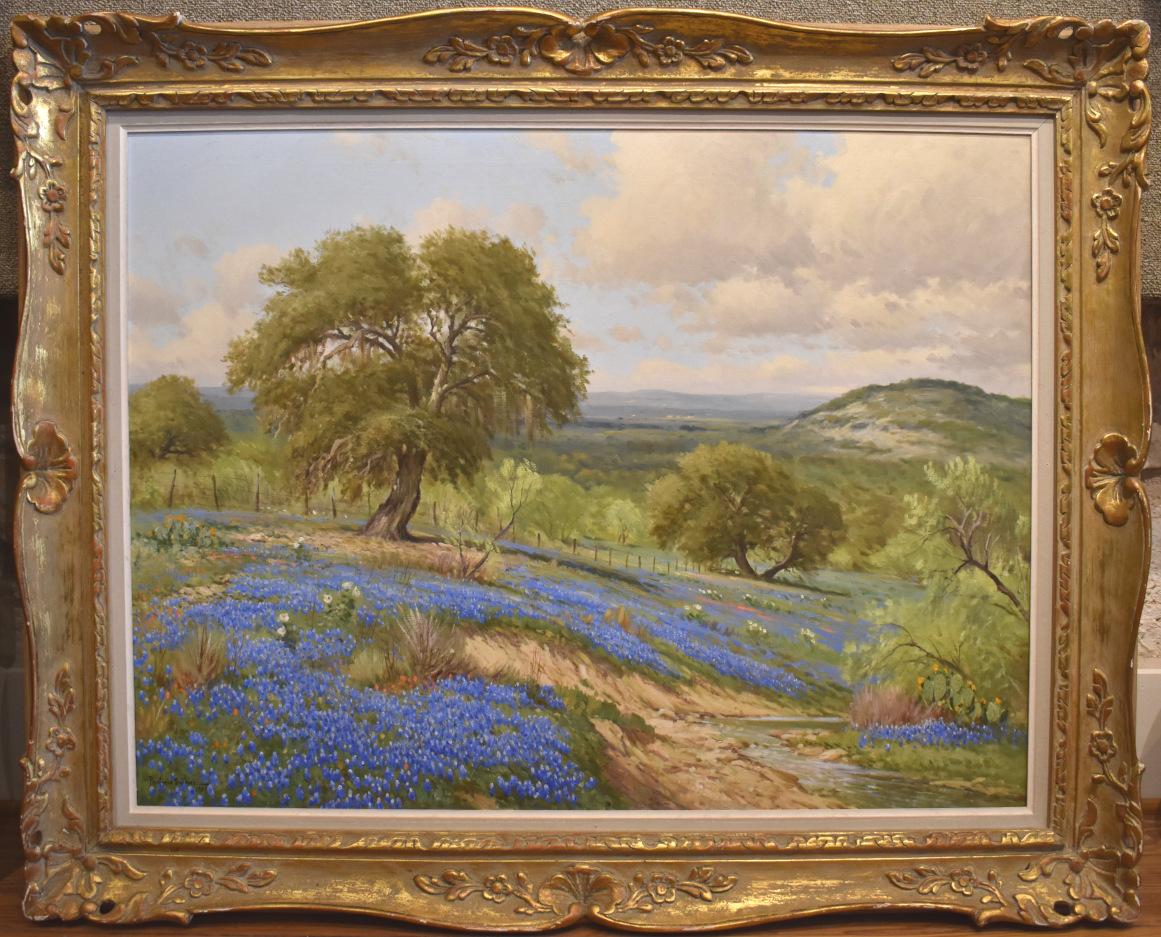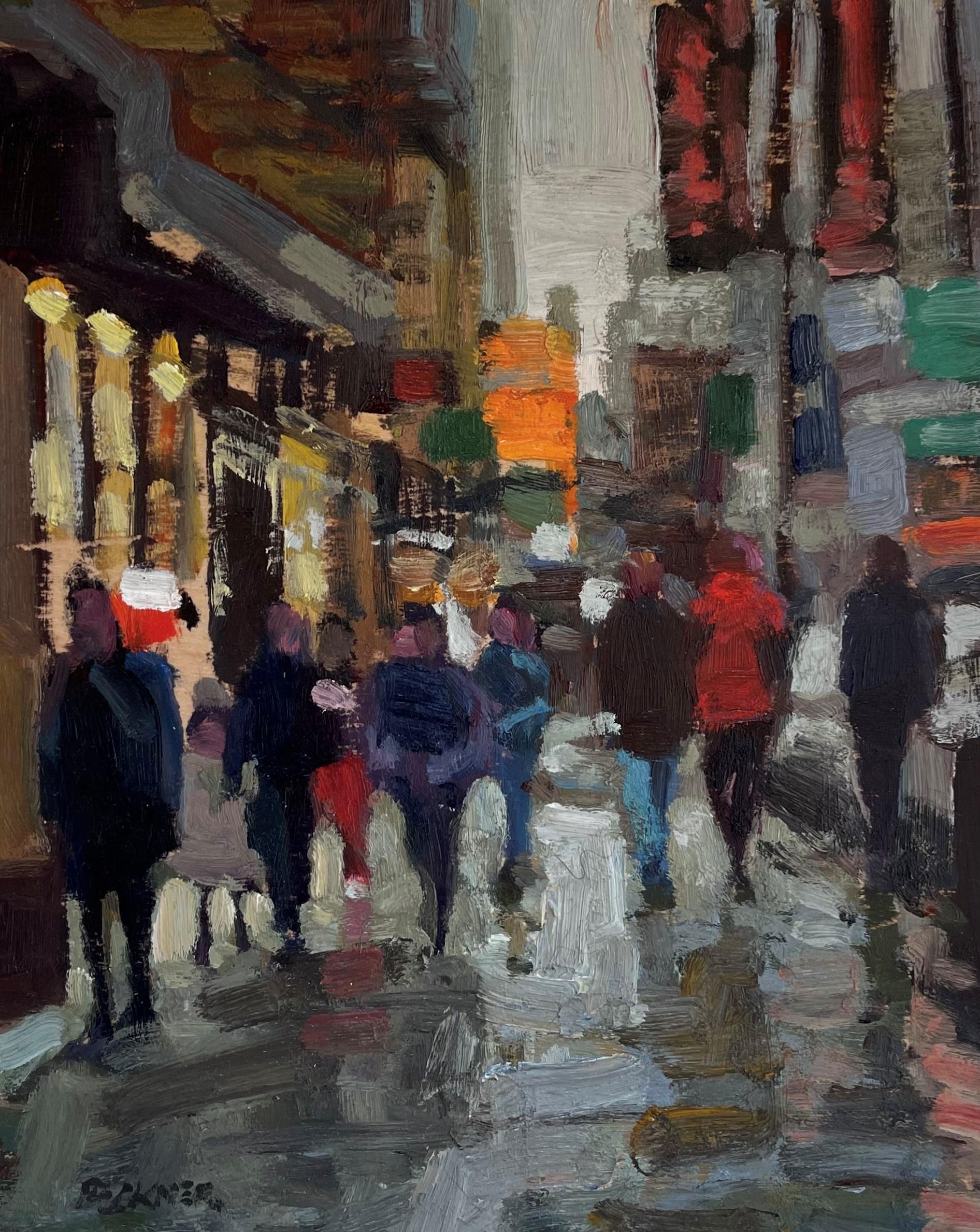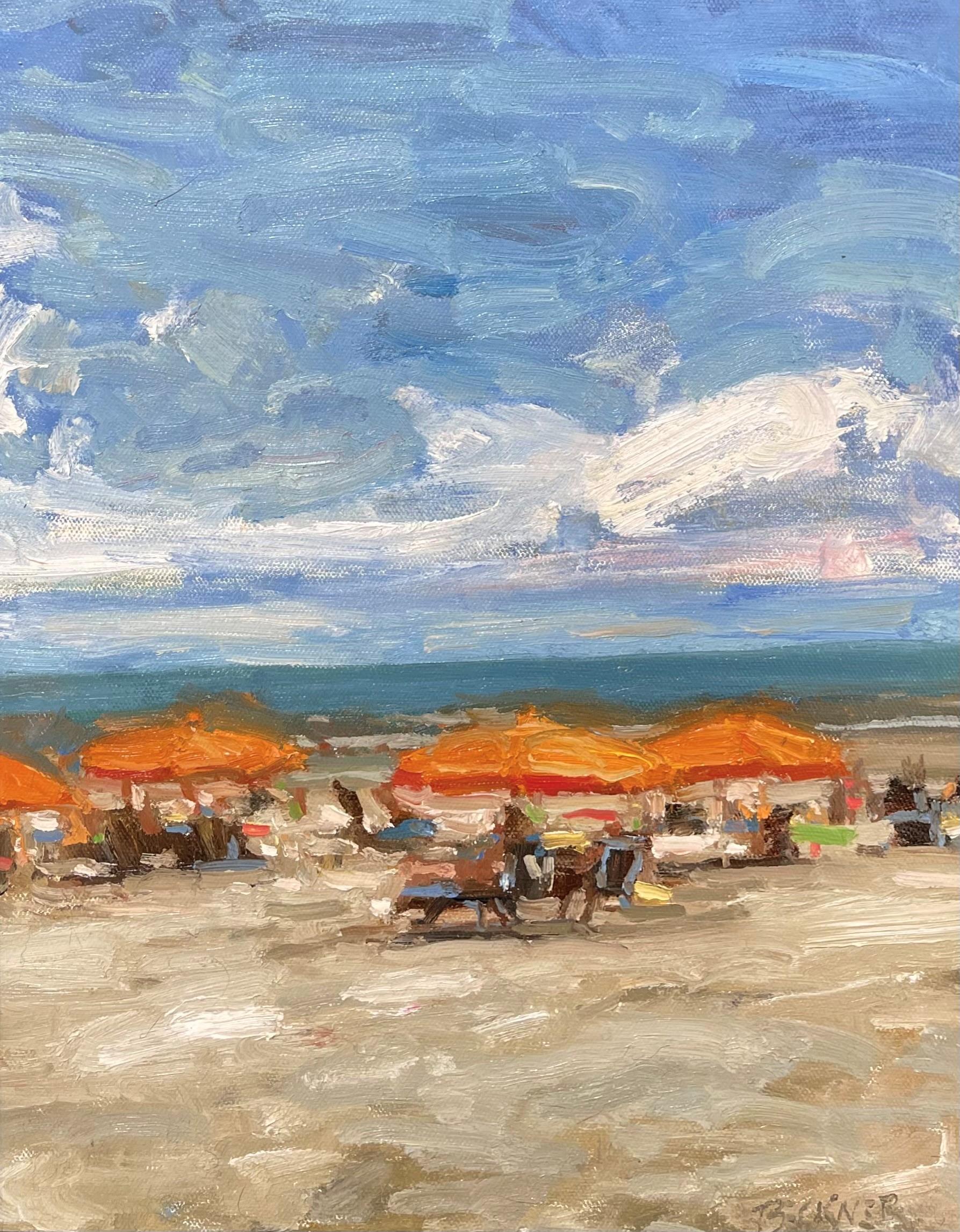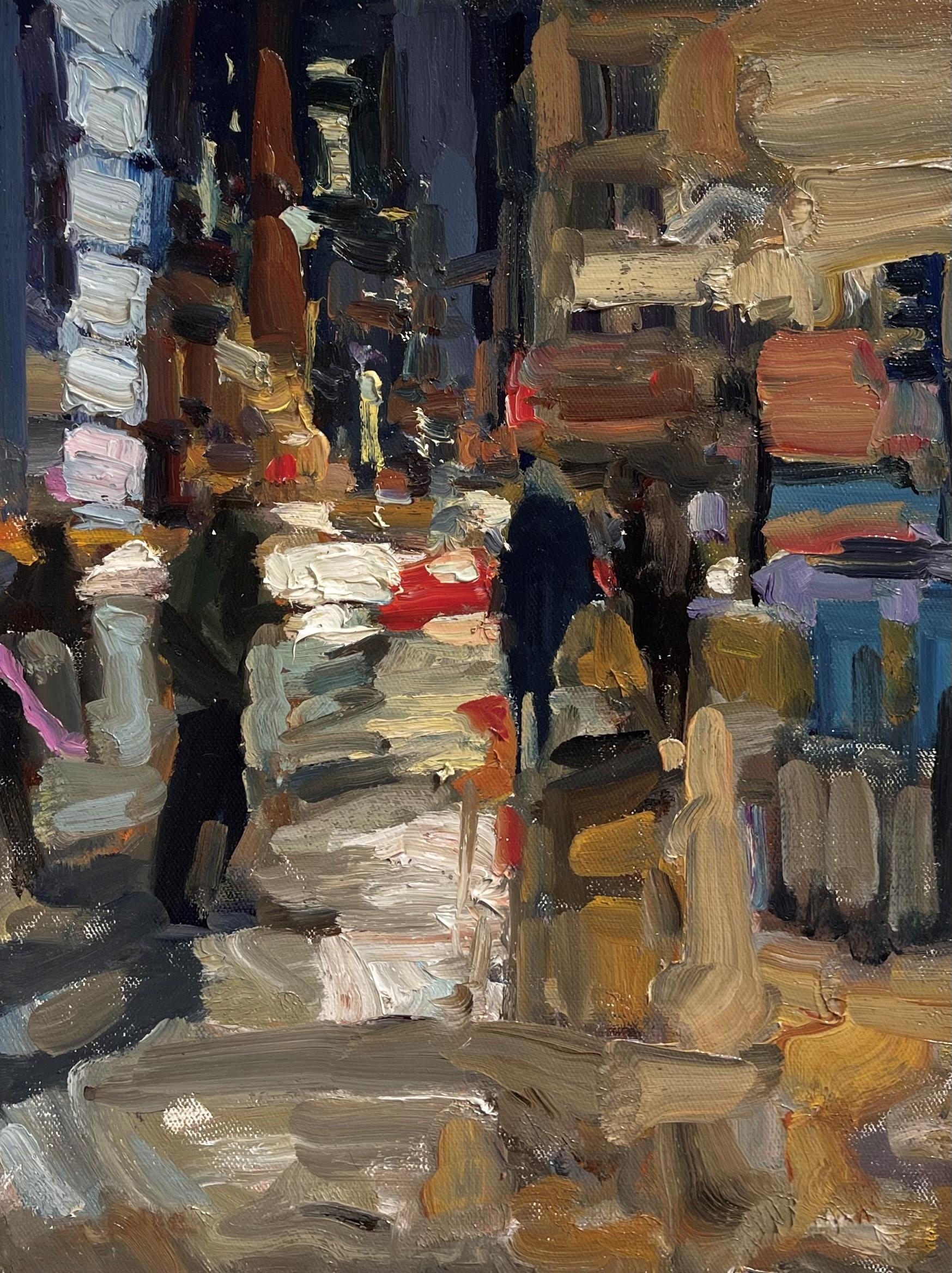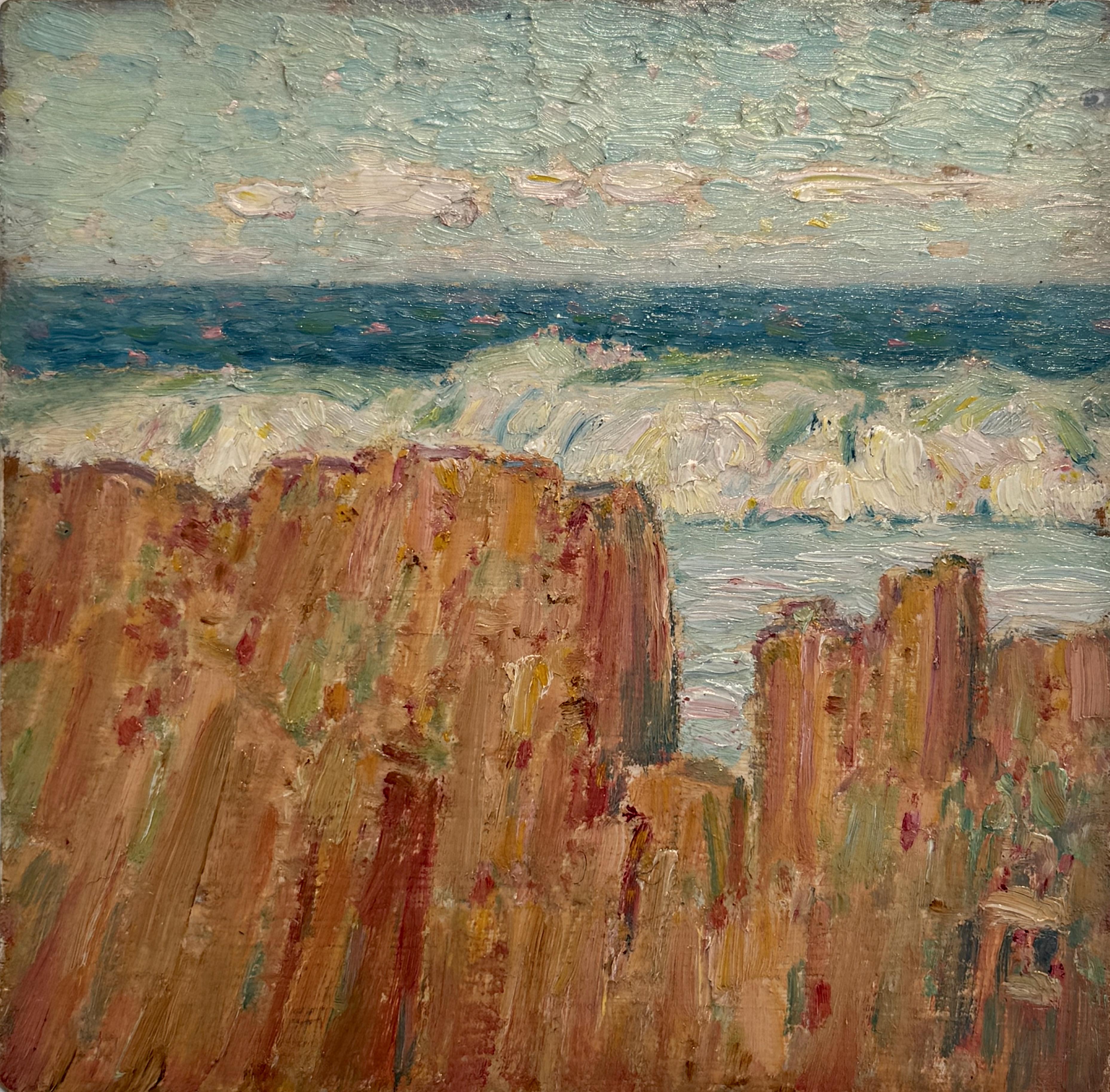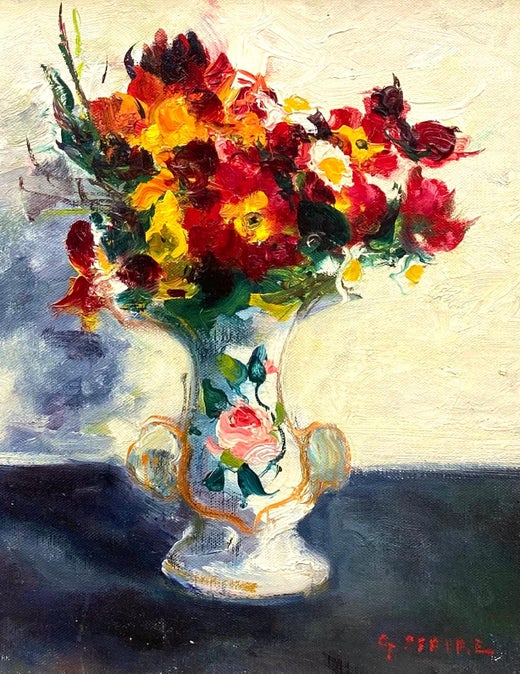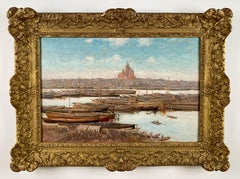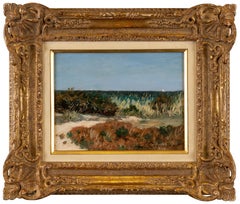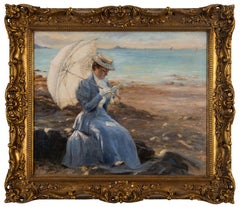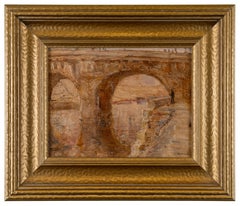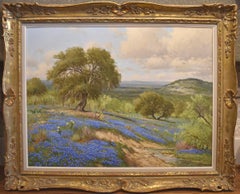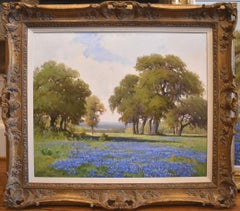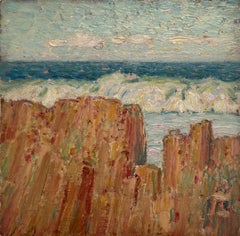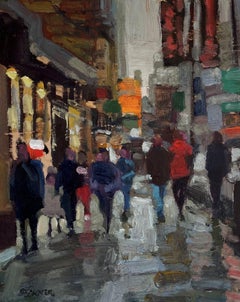Items Similar to Landscape with Figures
Want more images or videos?
Request additional images or videos from the seller
1 of 7
Gaston SebireLandscape with Figures
About the Item
Gaston Sebire
French, 1920-2001
Landscape with Figures
Oil on canvas
31 by 41 ½ in, w/ frame 38 by 48 ½ in
Signed lower right
Gaston Sebire was born August 18, 1920, in Saint-Samson Calvados. He was a painter of landscapes, seascapes, still lifes and flowers. Sebire was also an engraver, pastel artist and painter of theatre decorations. He settled in Paris in 1951. In 1953 he created the costumes and decorations for l'Ange Gris, with music by Debussy, for the Ballets of the marquis de Cuevas.
He lived and worked in Normandy and participated in numerous group exhibitions, including: Salon of Independents, Paris Salon of Tuileries, Paris Comparisons Salon since 1962, Paris Salon of French Artists since 1964, Paris. He appeared at other groupings in London with Lorjou and Clave, in Munich, Washington, Japan, and different exhibitions of the School of Paris at the Charpentier Gallery in Paris in 1953, 1954, a1955, 1956, 1946, 1958 and 1962, at the Biennial of the Jeunes au Pavilon of Marsan in 1957.
He had many solo exhibitions: 1944- Galerie Gosselin, Rouen 1952 - Galerie Visconti, Paris 1956 - Galerie Charpentier, Paris 1961 - Galerie Combes, Clermont-Ferrand 1962, 1965 and 1968 - Galerie Drouant, Paris 1964 - Musee de Rouen 1965 - Wally Findlay Gallery, New York, and Chicago 1965 and 1971 - Wally Findlay Gallery, Paris 1976 - Cultural Center, Le Mesnis-Esnard 1986 - Retrospective, Museum of Fine Art, Rouen 1991 - with Cacheux, Roger Worms Association, Ville de Montfermeil 1992 - Wally Findlay Gallery, Paris.
He received the Critic's Prize in 1953, the Greenshields Prize in 1957 and the Gold Medal at the Salon of French Artists in 1968. Today his work can be seen in Museums around the world.
Provenance:
Wally Findlay Galleries
Private Collection New York
Le Trianon Fine Art & Antiques
- Creator:Gaston Sebire (1920 - 2001, French)
- Dimensions:Height: 38 in (96.52 cm)Width: 48.5 in (123.19 cm)
- More Editions & Sizes:38 by 48 ½ inPrice: $8,200
- Medium:
- Movement & Style:
- Period:
- Condition:
- Gallery Location:Sheffield, MA
- Reference Number:Seller: 012771stDibs: LU700316134302
Gaston Sebire
Gaston Sébire was born August 18, 1920, in Saint-Samson Calvados Normandy. He was known for his landscapes, seascapes, still lifes and flowers. Sebire was also an engraver, pastel artist and painter of theatre decorations. He settled in Paris in 1951 and in 1953 he created the costumes and decorations for l'Ange Gris, with music by Debussy, for the Ballets of the Marquis de Cuevas. He lived and worked in Normandy and participated in numerous group exhibitions, including Salon of Independents, Paris Salon of Tuileries, Paris Comparisons Salon since 1962, Paris Salon of French Artists since 1964, Paris. He appeared at other groupings in London with Lorjou and Clave, in Munich, Washington, Japan, and different exhibitions of the School of Paris at the Charpentier Gallery in Paris in 1953, 1954, 1955, 1956, 1946, 1958 and 1962, at the Biennial of the Jeunes au Pavilon of Marsan in 1957. He received the Critic's Prize in 1953, the Greenshields Prize in 1957 and the Gold Medal at the Salon of French Artists in 1968. His first major achievement was to design the costumes and sets for L'Ange gris, a ballet by Claude Debussy for the Marquis de Cuevas in 1953. That same year, he won the Casa de Velázquez in Madrid, of which he was a member of the 24th artistic promotion, and leaves for Spain. And during the entire second half of the twentieth century, he exhibited in the main Parisian salons, and was notably part of Maurice Boitel's group at Comparisons show, for forty-five years. Today his work can be seen in Museums around the world and among his shows and exhibitions include: 1944 Galerie Gosselin in Rouen, France; 1952 Galerie Visconti in Paris, France; 1956 Galerie Charpentier in Paris, France; 1961 Galerie Combes in Clermont-Ferrand, France; 1962 Galerie Drouant in Paris, France; 1964 "Exhibition" Musee de Rouen in Rouen, France; 1965 Wally Findlay Gallery in New York and Chicago; 1965 Galerie Drouant in Paris, France; 1965 Wally Findlay Gallery in Paris, France; 1968 Galerie Drouant in Paris, France; 1971 Wally Findlay Gallery in Paris, France; 1976 "Exhibitions" Cultural Center in Le Mesnil-Esnard, France; 1986 "Retrospective" Museum of Fine Art in Rouen, France; 1991 Roger Worms Association with "Cacheux" in Ville de Montfermeil, France and in 1992 Wally Findlay Gallery in Paris, France. Gaston Sébire was appointed painter of the Navy in 1973 and he became a member of the Rouen Academy in 1973. Sébire died in 2001.
About the Seller
3.7
Vetted Professional Seller
Every seller passes strict standards for authenticity and reliability
1stDibs seller since 2017
51 sales on 1stDibs
Typical response time: 18 hours
- ShippingRetrieving quote...Shipping from: Sheffield, MA
- Return Policy
Authenticity Guarantee
In the unlikely event there’s an issue with an item’s authenticity, contact us within 1 year for a full refund. DetailsMoney-Back Guarantee
If your item is not as described, is damaged in transit, or does not arrive, contact us within 7 days for a full refund. Details24-Hour Cancellation
You have a 24-hour grace period in which to reconsider your purchase, with no questions asked.Vetted Professional Sellers
Our world-class sellers must adhere to strict standards for service and quality, maintaining the integrity of our listings.Price-Match Guarantee
If you find that a seller listed the same item for a lower price elsewhere, we’ll match it.Trusted Global Delivery
Our best-in-class carrier network provides specialized shipping options worldwide, including custom delivery.More From This Seller
View AllView of Alexander Nevsky Cathedral, Nizhny Novgorod
Located in Sheffield, MA
George Frost
America, 1843–1907
View of Alexander Nevsky Cathedral, Nizhny Novgorod
Oil on Canvas
20 by 30 in. W/frame 28 by 38 in.
Signed lower l...
Category
1880s Impressionist Landscape Paintings
Materials
Oil
St. Tropez Bord de Mer
Located in Sheffield, MA
Auguste Pegurier
French, 1856-1936
St. Tropez Bord de Mer
Oil on canvas
9 ¼ by 12 in, w/ frame 16 ¼ by 19 in
Signed lower right
Category
Early 20th Century Impressionist Landscape Paintings
Materials
Oil
A Love Letter by the Sea
Located in Sheffield, MA
Henri Bénard
French, 1860-1927
A Love Letter By the Sea
Oil on Canvas
19 ¾ by 24 in, w/ frame 26 by 30 in
Signed Henri Bénard lower left
Category
Late 19th Century Impressionist Landscape Paintings
Materials
Oil
Pont Neuf Bridge, France 1906
By Clarence Keiser Hinkle
Located in Sheffield, MA
Clarence Keiser Hinkle
American, 1880-1960
Pont Neuf Bridge, France 1906
Oil on board
10 ¾ by 13 ¾ in, w/ frame 18 by 21 in
Signed lower right
An academy trained California painter...
Category
Early 1900s American Impressionist Landscape Paintings
Materials
Oil
Young Girl Resting in a Bed of Flowers
Located in Sheffield, MA
James George Weiland
American, 1872-1968
Young Girl Resting in a Bed of Flowers
Oil on canvas
24 by 30 in. W/frame 30 by 36 in.
Signed lower left...
Category
1910s American Impressionist Figurative Paintings
Materials
Oil
Figures in the Forest
Located in Sheffield, MA
Carl Carlsen
Danish, 1855-1917
Figures in the Forest
Oil on canvas
Signed and dated ‘Carl Carlsen 1900’ lower right
24 ½ by 30 ½ in. w/frame 31 by 36 i...
Category
Early 1900s Impressionist Landscape Paintings
Materials
Oil
You May Also Like
"Bluebonnet Creek" Texas Hill Country 1957 39 x 49 Framed!!!
By Porfirio Salinas
Located in San Antonio, TX
Porfirio Salinas
(1910-1973)
San Antonio Artist
Image Size: 30 x 40
Frame Size: 39 x 49
Medium: Oil on Canvas
Dated 1957
"Bluebonnet Creek" Texas Hill Country
Biography
Porfirio Salinas (1910-1973)
Porfirio Salinas was a self-taught artist who painted landscapes of Central Texas with an emphasis on the vast bluebonnet fields that grow there in the springtime. Born in 1910 in Bastrop, Texas, he attended public schools in San Antonio. He also observed works in progress by the director of the San Antonio Art School, Jose Arpa, as well as landscape painter, Robert Wood. Wood is said to have paid Salinas five dollars a picture to paint bluebonnets because "he hated to paint bluebonnets". Salinas served in the military from 1943 to 1945. Although he was assigned to Fort Sam Houston, he was allowed to live at home. At the fort, Colonel Telesphor Gottchalk assigned him to paint murals for the officer's lounge and various other projects, and Salinas continued to be able to paint during his entire conscripted period. Even before he achieved notoriety among galleries, dealers, and museums, Salinas was widely followed and appreciated by many Texans, including former President Lyndon B. Johnson, who may be considered responsible for launching Salinas popularity beyond the boundaries of Texas. In 1973, Texas capital, Austin, honored Salinas for having "done much to bring the culture of Mexico and Texas closer together with his paintings". Salinas died in April 1973 in San Antonio, Texas.
From
the years of the Great Depression through President Lyndon Johnson's
Great Society of the 1960s, Texan Porfirio Salinas (1910-1973) remained
one of the Lone Star State's most popular artists. Today, his works
remain popular with Texas collectors and those who love landscapes of
the beautiful "Hill Country" that lies in the center of the
state. One of the first Mexican American painters to become
widely recognized for his art, Salinas was a favorite of President
Lyndon Johnson and his wife, Lady Bird Johnson, as well as of Sam
Rayburn, the longest-serving Speaker of the House of Representatives,
and Texas Governor John Connelly. In fact, President Johnson was so
enamored with his Salinas paintings that the artist will forever be
associated with America's first Texas-born President. Works by Porfirio
Salinas are in a number of museum collections, grace the halls of the
Texas State Capitol and the Governor's Mansion in Austin, and are
included in virtually every major private collection of Early Texas Art.
Porfirio
Salinas was born on November 6, 1910, near the small town of Bastrop,
Texas, about thirty miles from Austin. His father, Porfirio G. Salinas
(1881-1967), and his mother, Clara G. Chavez, struggled to make a
hardscrabble living as tenant farmers, but eventually were forced to
give up farming. The family moved to San Antonio, where Salinas' father
was able to get a job working as a laborer for the railroad, but the
scenic area around Bastrop, with its pine trees and the wide expanse of
the Rio Grande River, would forever remain a touchstone for the artist.
For the rest of his life, Salinas and his brothers went back frequently
to visit their grandmother in her little farmhouse. When in Bastrop,
Porfirio painted on the banks of the Rio Grande or in the groves of
pine trees. The Salinas family was close-knit and Porfirio was the
middle child of five children, so he had an older brother and sister as
well as a younger brother and sister. His mother was a native of
Mexico, so throughout his childhood the family made the long drive to
Mexico to visit Clara Salinas' family.
As a child growing up in
the bi-lingual section of San Antonio, Salinas drew and painted
incessantly and by the time he was ten, he was already producing work
that was mature enough to sell to his schoolteachers. Many years later
in an article in the New York Times he was described as a "boy whose
textbooks were seldom opened and whose sketchbook was never closed."
Instead of studying, the young artist spent his spare time watching
artists paint in and around San Antonio. As an aspiring painter,
Salinas was fortunate to grow up in the historic city, which had the
most active art scene in Texas. It was his exposure to older,
professional painters that encouraged the precocious young painter to
leave school early in order to help his family and pursue a career as a
professional artist, despite his father's inability to see art as a
career with any future for his son.
When Salinas was about
fifteen he came to know the artist Robert W. Wood (1889-1979). He met
Wood while he was employed in an art supply store and he soon began to
work as an assistant to the English-born painter, who had moved from
Portland to San Antonio in 1924. Although the diminutive Englishman was
already an established professional artist, he did not have a great
deal of formal art training and so he was then studying with the
academically trained Spanish painter Jose Arpa (1858-1952) in order to
augment his knowledge and give his work a more polished look. Salinas
was an eager young man, and while working in Wood's downtown San
Antonio studio he learned to stretch canvases, frame paintings and to
sketch in larger compositions from small plein-air studies for the
English artist. He began to accompany Wood and Arpa to the hills
outside San Antonio, where they painted small Plein-air studies of
fields of blue lupin - the state flower, the famous "Bluebonnets" of
Texas - in the springtime and scenes of the gnarled Red Oaks as they
changed color in the fall. He was soon assisting Wood in the tedious
work of painting the tiny blue flowers that collectors wanted to see in
the landscapes they purchased of central Texas. According to a
1972 newspaper story, "Legend has it that one day in the 1920s artist
Robert Wood decided he could not bear to paint another bluebonnet in
one of his landscapes. He hired young Porfirio Salinas to paint
them in for him at five dollars a painting." Whether this story is
accurate or apocryphal isn't clear, but the ambitious and independent
young Salinas wasn't destined to be anyone's assistant for very long.
The
formative event of Porfirio Salinas' teenage years was the Texas
Wildflower Competitive Exhibitions, a Roaring-Twenties dream of the
eccentric oilman Edgar B. Davis (1873-1951). These competitive shows of
paintings of wildflowers and Texas life were mounted in San Antonio
from 1927 to 1929. Held at the newly opened Witte Museum each spring,
the exhibition featured large cash prizes donated by the philanthropic
Davis, which were an inducement for artists to travel from all over the
United States to paint in the Hill Country of Texas. The "Davis
Competitions," as they were known, helped to cement San Antonio's
reputation as an art center, a legacy that remains with the "River
City" today. The shows generated a great deal of excitement in the
area, helping to make celebrities of the some of the artists who had
already settled there and encouraging others to make San Antonio their
home. Over the three years that the wildflower competitions were held,
more than 300 paintings were exhibited, and many thousands of viewers
saw the paintings at the Witte Museum and on tours throughout the state
and in New York. Each year Davis would generously purchase the winning
paintings and then donate them to the San Antonio Art League. Young
Porfirio Salinas would have been able to not only watch his two mentors
- Robert W. Wood and Jose Arpa - paint the works that they entered in
the Davis Competitions, he would have been able to see Arpa take
several of the major prizes, receiving the judge's accolades for
"Verbena," "Cactus Flower" and "Picking Cotton," works that are still
on view at the San Antonio Art League Museum today. Unfortunately,
Davis eventually put his donations to work in other charitable
endeavors, bringing to an end the wildflower events, but only after
they inspired Salinas and other young painters and had helped to make
wildflower paintings the most sought-after subject for traditionalist
Texas collectors.
In 1930, when he was only twenty, Salinas
hung out a shingle and began to paint professionally, augmenting the
sales of his easel paintings with what little business he could garner
by painting signs for local concerns. It was a struggle for the young
artist to make a living, as the effects of the Great Depression were
settling in. His early works are very similar to those of Robert
Wood's, both in subject matter and treatment. Salinas did small
paintings of Bluebonnets for the tourists who visited San Antonio to
see the famous Alamo as well as paintings of the Texas missions...
Category
1950s Impressionist Landscape Paintings
Materials
Oil
"Lazy Days Blues" TEXAS BLUEBONNETS, NICE LARGER SIZE LANDSCAPE CIRCA 1950
By Porfirio Salinas
Located in San Antonio, TX
Porfirio Salinas
(1910-1973)
San Antonio Artist
Image Size: 25 x 30
Frame Size: 34 x 39
Medium: Oil on Canvas
Circa 1950
"Lazy Day Blues" Texas Bluebonnet
Biography
Porfirio Salinas (1910-1973)
Porfirio Salinas was a self-taught artist who painted landscapes of Central Texas with an emphasis on the vast bluebonnet fields that grow there in the springtime. Born in 1910 in Bastrop, Texas, he attended public schools in San Antonio. He also observed works in progress by the director of the San Antonio Art School, Jose Arpa, as well as landscape painter, Robert Wood. Wood is said to have paid Salinas five dollars a picture to paint bluebonnets because "he hated to paint bluebonnets". Salinas served in the military from 1943 to 1945. Although he was assigned to Fort Sam Houston, he was allowed to live at home. At the fort, Colonel Telesphor Gottchalk assigned him to paint murals for the officer's lounge and various other projects, and Salinas continued to be able to paint during his entire conscripted period. Even before he achieved notoriety among galleries, dealers, and museums, Salinas was widely followed and appreciated by many Texans, including former President Lyndon B. Johnson, who may be considered responsible for launching Salinas popularity beyond the boundaries of Texas. In 1973, Texas capital, Austin, honored Salinas for having "done much to bring the culture of Mexico and Texas closer together with his paintings". Salinas died in April 1973 in San Antonio, Texas.
From
the years of the Great Depression through President Lyndon Johnson's
Great Society of the 1960s, Texan Porfirio Salinas (1910-1973) remained
one of the Lone Star State's most popular artists. Today, his works
remain popular with Texas collectors and those who love landscapes of
the beautiful "Hill Country" that lies in the center of the
state. One of the first Mexican American painters to become
widely recognized for his art, Salinas was a favorite of President
Lyndon Johnson and his wife, Lady Bird Johnson, as well as of Sam
Rayburn, the longest-serving Speaker of the House of Representatives,
and Texas Governor John Connelly. In fact, President Johnson was so
enamored with his Salinas paintings that the artist will forever be
associated with America's first Texas-born President. Works by Porfirio
Salinas is in a number of museum collections, grace the halls of the
Texas State Capitol and the Governor's Mansion in Austin, and are
included in virtually every major private collection of Early Texas Art.
Porfirio
Salinas was born on November 6, 1910, near the small town of Bastrop,
Texas, about thirty miles from Austin. His father, Porfirio G. Salinas
(1881-1967), and his mother, Clara G. Chavez, struggled to make a
hardscrabble living as tenant farmers, but eventually were forced to
give up farming. The family moved to San Antonio, where Salinas' father
was able to get a job working as a laborer for the railroad, but the
scenic area around Bastrop, with its pine trees and the wide expanse of
the Rio Grande River, would forever remain a touchstone for the artist.
For the rest of his life, Salinas and his brothers went back frequently
to visit their grandmother in her little farmhouse. When in Bastrop,
Porfirio painted on the banks of the Rio Grande or in the groves of
pine trees. The Salinas family was close-knit, and Porfirio was the
middle child of five children, so he had an older brother and sister as
well as a younger brother and sister. His mother was a native of
Mexico, so throughout his childhood the family made the long drive to
Mexico to visit Clara Salinas' family.
As a child growing up in
the bi-lingual section of San Antonio, Salinas drew and painted
incessantly and by the time he was ten, he was already producing work
that was mature enough to sell to his schoolteachers. Many years later
in an article in the New York Times he was described as a "boy whose
textbooks were seldom opened and whose sketchbook was never closed."
Instead of studying, the young artist spent his spare time watching
artists paint in and around San Antonio. As an aspiring painter,
Salinas was fortunate to grow up in the historic city, which had the
most active art scene in Texas. It was his exposure to older,
professional painters that encouraged the precocious young painter to
leave school early in order to help his family and pursue a career as a
professional artist, despite his father's inability to see art as a
career with any future for his son.
When Salinas was about
fifteen he came to know the artist Robert W. Wood (1889-1979). He met
Wood while he was employed in an art supply store and he soon began to
work as an assistant to the English-born painter, who had moved from
Portland to San Antonio in 1924. Although the diminutive Englishman was
already an established professional artist, he did not have a great
deal of formal art training and so he was then studying with the
academically trained Spanish painter Jose Arpa (1858-1952) in order to
augment his knowledge and give his work a more polished look. Salinas
was an eager young man, and while working in Wood's downtown San
Antonio studio he learned to stretch canvases, frame paintings and to
sketch in larger compositions from small plein-air studies for the
English artist. He began to accompany Wood and Arpa to the hills
outside San Antonio, where they painted small Plein-air studies of
fields of blue lupin - the state flower, the famous "Bluebonnets" of
Texas - in the springtime and scenes of the gnarled Red Oaks as they
changed color in the fall. He was soon assisting Wood in the tedious
work of painting the tiny blue flowers that collectors wanted to see in
the landscapes they purchased of central Texas. According to a
1972 newspaper story, "Legend has it that one day in the 1920s artist
Robert Wood decided he could not bear to paint another bluebonnet in
one of his landscapes. He hired young Porfirio Salinas to paint
them in for him at five dollars a painting." Whether this story is
accurate or apocryphal isn't clear, but the ambitious and independent
young Salinas wasn't destined to be anyone's assistant for very long.
The
formative event of Porfirio Salinas' teenage years was the Texas
Wildflower Competitive Exhibitions, a Roaring-Twenties dream of the
eccentric oilman Edgar B. Davis (1873-1951). These competitive shows of
paintings of wildflowers and Texas life were mounted in San Antonio
from 1927 to 1929. Held at the newly opened Witte Museum each spring,
the exhibition featured large cash prizes donated by the philanthropic
Davis, which were an inducement for artists to travel from all over the
United States to paint in the Hill Country of Texas. The "Davis
Competitions," as they were known, helped to cement San Antonio's
reputation as an art center, a legacy that remains with the "River
City" today. The shows generated a great deal of excitement in the
area, helping to make celebrities of the some of the artists who had
already settled there and encouraging others to make San Antonio their
home. Over the three years that the wildflower competitions were held,
more than 300 paintings were exhibited, and many thousands of viewers
saw the paintings at the Witte Museum and on tours throughout the state
and in New York. Each year Davis would generously purchase the winning
paintings and then donate them to the San Antonio Art League. Young
Porfirio Salinas would have been able to not only watch his two mentors
- Robert W. Wood and Jose Arpa - paint the works that they entered in
the Davis Competitions, he would have been able to see Arpa take
several of the major prizes, receiving the judge's accolades for
"Verbena," "Cactus Flower" and "Picking Cotton," works that are still
on view at the San Antonio Art League Museum today. Unfortunately,
Davis eventually put his donations to work in other charitable
endeavors, bringing to an end the wildflower events, but only after
they inspired Salinas and other young painters and had helped to make
wildflower paintings the most sought-after subject for traditionalist
Texas collectors.
In 1930, when he was only twenty, Salinas
hung out a shingle and began to paint professionally, augmenting the
sales of his easel paintings with what little business he could garner
by painting signs for local concerns. It was a struggle for the young
artist to make a living, as the effects of the Great Depression were
settling in. His early works are very similar to those of Robert
Wood's, both in subject matter and treatment. Salinas did small
paintings of Bluebonnets for the tourists who visited San Antonio to
see the famous Alamo as well as paintings of the Texas missions...
Category
1950s Impressionist Landscape Paintings
Materials
Oil
Santa Barbara California Ocean Waves Coastal Scene Impressionist Plein Air #0-99
By Francis Draper Jr.
Located in Rancho Santa Fe, CA
Estate signed verso. Painted between the years 1916 and 1926. This painting is identified in the Francis Draper Jr. archives as #0-99........... PROVENANCE: The Francis Draper Jr. Estate........ PLEASE INQUIRE ABOUT THE ENTIRE COLLECTION OF THESE WONDERFUL CALIFORNIA PLEIN AIR IMPRESSIONIST...
Category
1910s American Impressionist Landscape Paintings
Materials
Oil, Cardboard
"Eastside, " Urban Night Scene by Jim Beckner
By Jim Beckner
Located in Denver, CO
Jim Beckner's (US based) "Bright Lights" is an original, handmade oil painting depicting pedestrians strolling down a city street at dusk.
About the Artist:
(Born 1970)
Denver-bas...
Category
2010s Impressionist Figurative Paintings
Materials
Oil, Board
"Intersection, " Abstracted Urban Night Scene by Jim Beckner
By Jim Beckner
Located in Denver, CO
Jim Beckner's (US based) "Intersection" is an original, handmade oil painting depicting an abstracted city scene at night.
About the Artist:
(Born 1970)
Denver-based artist Jim Be...
Category
2010s Impressionist Figurative Paintings
Materials
Canvas, Oil, Board
Spring - Pocasset MA
By Aldro Thompson Hibbard
Located in Milford, NH
A fine New England Cape Cod landscape by American artist Aldro Thompson Hibbard (1886-1972). Hibbard was born in Falmouth, MA, studied at the Massachusetts College of Art and at the Boston Museum School with artists such as Edmond Tarbell, Frank W. Benson, Joseph R. DeCamp, and later became one of the founders of the Rockport Art Colony, living on Cape Ann in Massachusetts and summering in Jamaica...
Category
Early 20th Century American Impressionist Landscape Paintings
Materials
Canvas, Oil
